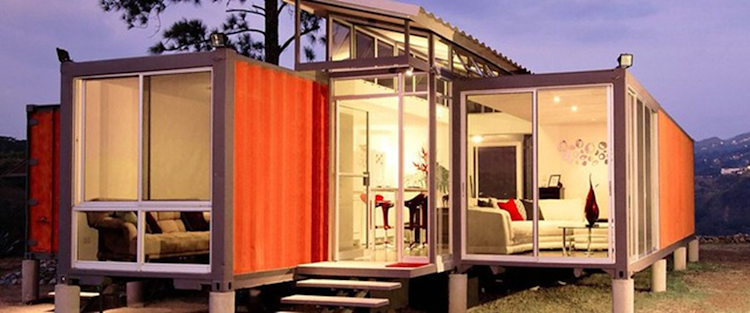Building homes with shipping containers is fast, modern, innovative, and inexpensive. Have you considered using container architecture for your dream home design?
Building luxury homes with shipping containers is a relatively new industry. Fairly used shipping containers that usually serve as anything from storage facilities to temporary building site offices have now found a place in the luxury homes industry.
Now that people are re-evaluating their lifestyles, creating beautiful abodes with these containers is trending as a stylishly downsizing way of living and with fewer available plots to build on in the cities, container architecture is a new way to meet the needs of the 21st-century homeowner with small plots of land.
Shipping containers are readily available, inexpensive, and convenient to use, come in simple standardized shapes and are easy to form beautiful architectural configurations when you use two or more to construct your home.

The Benefits of Structuring Containers into Lavish Homes
When you build with shipping containers, your savings are substantial with building material costs at the barest minimum while saving on construction time.
Building using containers offers a green and sustainable approach to conventional construction because shipping containers are factory-built to serve for freighting and can be upcycled for use by designing and assembling them as residential and commercial structures. This design and structuring system is referred to as container architecture.
Aspiring homeowners who dare to be different can build their dream homes using this recent form of sustainable design.
Reasons to Opt for Container Architecture
- Seeking an affordable way to own a home.
- Wanting to deviate from the norm.
- The best way to use a small or narrow lot judiciously.
- Looking for massive savings on home building construction costs.
- Finding ways to reduce the typically high home maintenance costs.
- Building homes with shipping containers is simple and fast.
- The concept is winning converts all over the world.
- Removes the challenges of sourcing for massive building funds.
What You Need to Know Before Building Shipping Container Homes
Before you construct your home with shipping containers, prepare adequately and know the steps to take.
1. Building and planning regulations
Depending on where you reside and what you intend to erect, you will require building permission and/or council consent. For example, if you are building with just one 20-foot container, you may not need council consent. For a larger home, if you wish to stack them to create a two or three-storey structure, you will need building permission.
During your planning stage, find out from the relevant local council about the application process required. Achieving the best results without running into unnecessary hitches is all about preparation.
2. Find the right builder
It is unwise to build the structure as a DIY unless you are a professional builder with some container architecture expertise. It isn’t advisable to self-build with this. The task is best approached with professional drawing services and competent structural engineering. Whoever you work with must also understand interior and exterior finishing for shipping containers.
3. Research for complex architectural designs
If you plan to create a more complicated structure you must do some thorough research. Building a house with shipping containers may seem like a breeze, something similar to building and stacking Lego blocks in a creative form. It is not. You have to think of its engineering aspects as well.
Additionally, building with steel structures is certainly more complicated than what you will learn from a YouTube video tutorial.
Step-By-Step Guide to Building Container Houses
To cut the time of endless research, you can also find complete guides to building shipping container homes that will provide a detailed step-by-step walk-through.
In this book, A Guide on How to Build and Move into Shipping Container Homes with Examples of Plans and Designs, you will learn about selection, transportation, structure foundation, utilities, and finishing.
Each chapter shows pictures of real-life examples to help put the theory of construction into tangible terms. Think of it this way, you want to approach building your dream house from an educated perspective to avoid unforeseen construction problems, traps, and pitfalls.
From luxury homes to schools, clinics, offices, and workshops, up-cycling materials is eco-friendly. Containers classified as industrial cast-offs are being creatively turned into sustainable living spaces – a clever idea that many 21st-century prospective homeowners respond to positively.